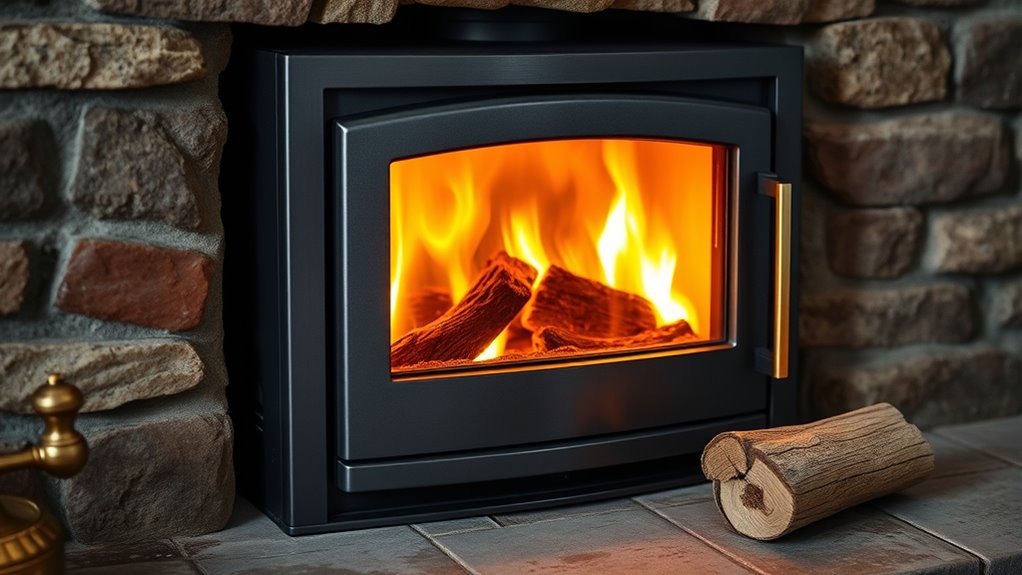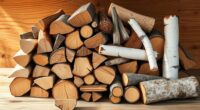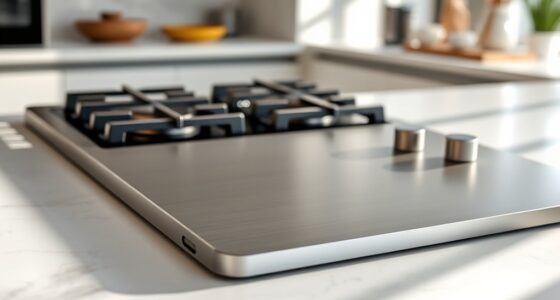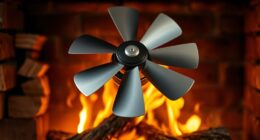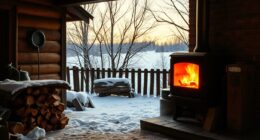Wood stove inserts are a smart choice if you want efficient, eco-friendly heating that cuts fuel costs and improves indoor air quality. They offer high efficiency, with EPA-certified models producing fewer emissions, and come in durable materials like cast iron or steel. Proper installation, choosing the right size, and features like airflow control can maximize their benefits. If you’re curious about whether they fit your home and how to get the most from them, there’s more to evaluate.
Key Takeaways
- They offer higher efficiency and cleaner burning, reducing fuel costs and environmental impact.
- Proper sizing, installation, and maintenance are essential for safe, effective, and long-lasting heating.
- Material options like cast iron or steel influence durability, appearance, and heat retention.
- They can be a cost-effective heating solution for homes with good insulation and appropriate firebox size.
- Certification and advanced combustion technology ensure compliance with emissions standards and optimal performance.
Understanding the Benefits of Wood Stove Inserts
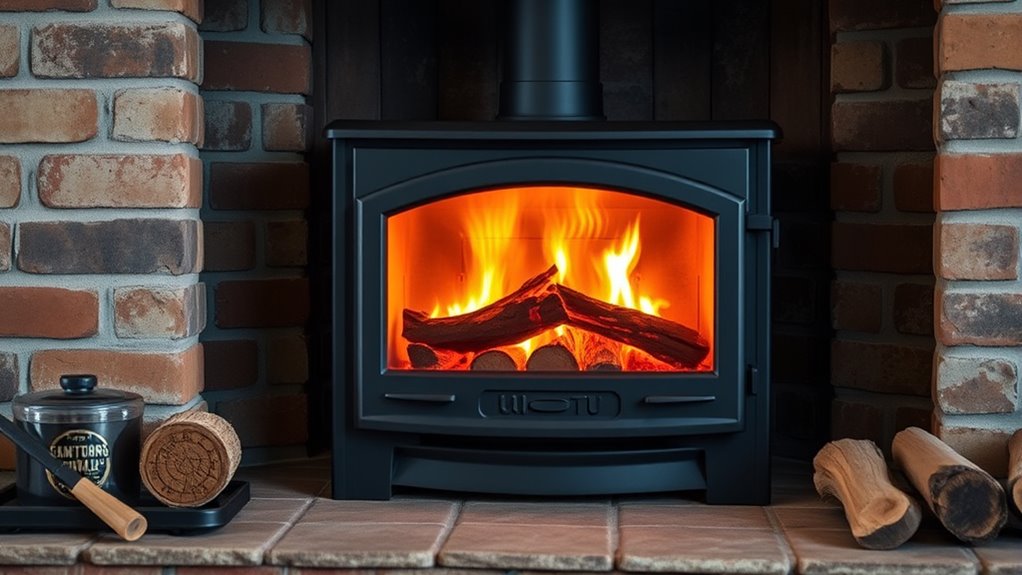
Wood stove inserts offer a practical upgrade to your existing fireplace, providing higher efficiency and more effective heating. These inserts enhance heat output by converting more of the wood’s energy into warmth, reducing heat loss common with open fireplaces. They achieve better combustion, with efficiencies around 70-75%, which means you use less fuel while generating more heat. Since they burn renewable fuel—wood—they’re an eco-friendly choice that supports sustainable home heating. Many models are EPA-certified, ensuring cleaner burning and lower emissions, often under 4.1 grams of smoke per hour. The enclosed design improves safety by minimizing sparks, embers, and drafts, making them ideal for overnight use and households with children or pets. Additionally, cost-effective options are available, making them an economical choice for many homeowners. Proper maintenance and operation can further enhance their performance and longevity. Regular inspection of the chimney and vent system is also recommended to prevent creosote buildup and ensure optimal operation. Incorporating advanced features can further improve efficiency and safety standards. Overall, wood stove inserts boost your home’s heating efficiency and safety, saving money and energy.
Evaluating Different Material Options for Fireplaces
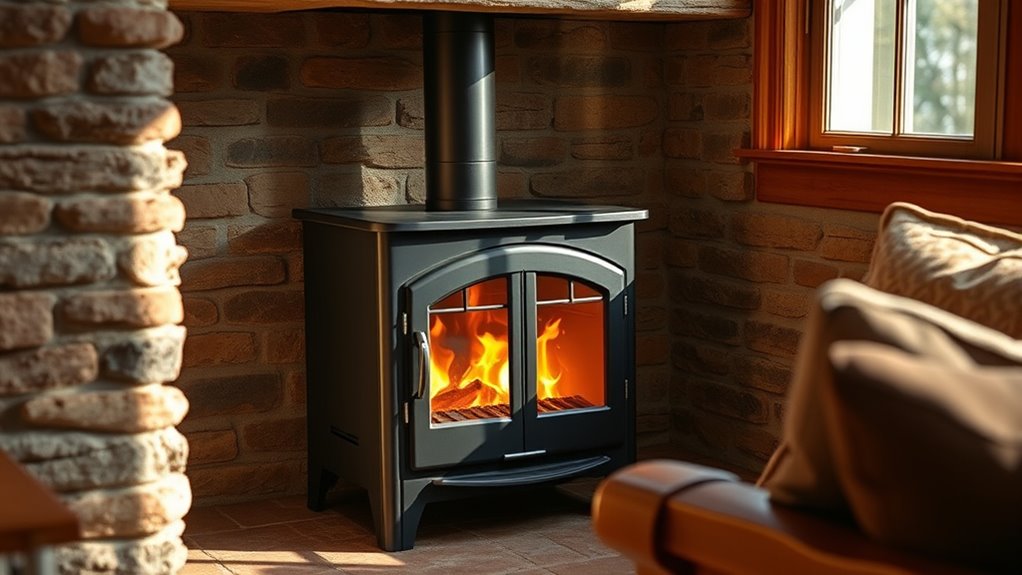
When choosing materials for your fireplace or stove, understanding the differences between cast iron and welded steel is essential. Cast iron offers a classic appearance and builds substantial mass, which helps with heat retention and steady warmth. However, it requires rebuilding every few years due to potential cracking. Steel, on the other hand, is more affordable, easier to maintain, and has improved durability with replaceable parts, making it a practical material option. Modern steel stoves can match the efficiency of cast iron models, providing reliable heat if designed well. Durability and ease of maintenance are key factors to consider when selecting a material for your stove or fireplace insert. Additionally, material performance in various operating conditions can influence long-term satisfaction. Choosing a stove with proper installation and venting ensures safety and efficiency, especially when considering different materials. Premium fireplace inserts sometimes incorporate stone or brick to mimic cast iron’s building mass and heat retention. Your choice impacts both appearance and performance, so consider durability, efficiency, and style when evaluating material options for your stove or fireplace insert. Properly selecting materials can also affect your overall energy efficiency, leading to cost savings over time.
Exploring Combustion Technologies and Emission Controls
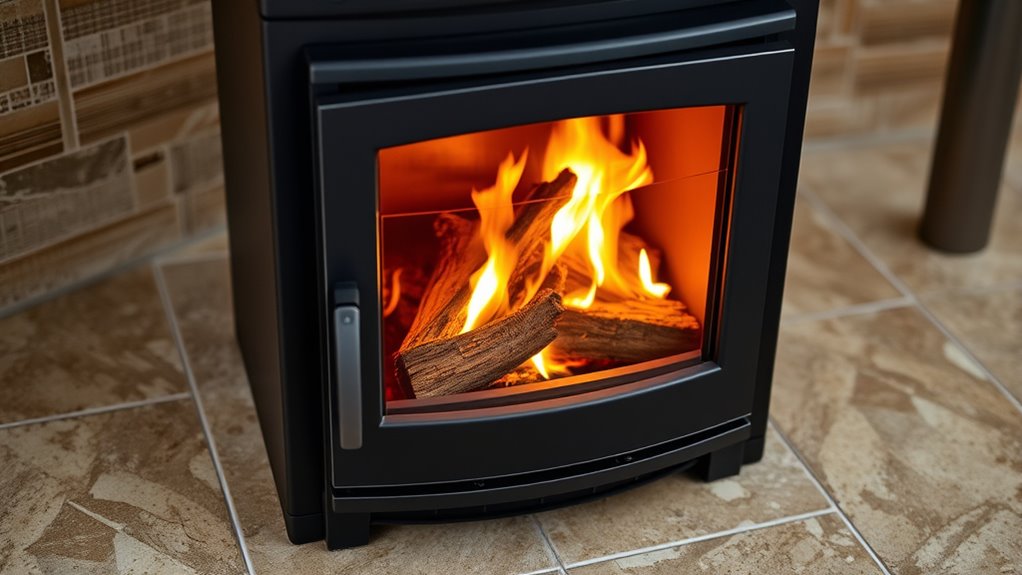
When choosing a wood stove insert, understanding combustion technologies helps you balance efficiency and emissions. Catalytic models offer long-lasting heat but require regular catalyst replacement, while non-catalytic stoves focus on cleaner burns with less maintenance. Both types meet EPA standards, but advanced designs can maximize efficiency and reduce environmental impact. Additionally, considering vetted product reviews can help identify the most reliable and effective options available. Incorporating emission controls into your decision can further enhance environmental benefits and ensure compliance with regulations. Recognizing technological advancements can also guide you toward environmentally friendly choices, such as innovations in combustion efficiency that reduce emissions while maintaining heat output. Staying informed about regional regulations can also ensure your stove choices are compliant with local standards and policies.
Catalytic vs. Non-Catalytic
Catalytic and non-catalytic stove technologies each employ different methods to achieve efficient combustion and reduce emissions. A catalytic stove uses a ceramic honeycomb catalyst to improve burn quality, resulting in steady, long-lasting heat output and lower emissions. However, it requires periodic catalyst replacement and more maintenance. In contrast, a non-catalytic stove relies on insulation, baffles, and pre-heated air to optimize combustion, producing a “peaky” heat curve with fewer degradation issues and simpler maintenance. Both types burn cleaner than older models, often meeting EPA standards with emissions below 4 grams per hour. While catalytic stoves offer a more consistent burn, non-catalytic designs tend to be easier to operate and maintain, with a more visually appealing fire and less risk of glass blackening at low burn rates. Additionally, understanding the energetic alignment involved in choosing a stove can enhance the overall efficiency and satisfaction of your heating system. A new technological advancement in combustion systems can further improve emission reductions and fuel efficiency. An awareness of fuel consumption rates can also help you select the most suitable stove for your needs and ensure optimal performance. Moreover, selecting the appropriate stove type can influence the long-term operational costs and maintenance requirements of your heating setup. Considering the emission controls used in each technology can further guide your decision towards a more environmentally friendly choice.
Emission Standards and Efficiency
Advances in combustion technologies have enabled wood stoves to meet stringent emission standards while maximizing efficiency. Modern EPA-compliant stoves, whether catalytic or non-catalytic, emit minimal particulate matter—often between 1-4 g/h—and reduce pollutant emissions appreciably. Catalytic stoves use a ceramic honeycomb catalyst to sustain steady heat but require periodic replacement. Non-catalytic stoves rely on enhanced combustion environments created by insulation, baffles, and pre-heated air, resulting in cleaner burns with less component wear. Technologies like secondary air injection improve burn efficiency, often exceeding 80%, while decreasing emissions. Enhanced airflow management plays a crucial role in achieving higher combustion efficiencies and cleaner emissions. Proper airflow control helps optimize combustion efficiency and further reduce pollutants. Better airflow control techniques have been developed to improve overall stove performance and reduce emissions even further. Cheaper, leaky stoves bypass these standards, produce more smoke, and emit higher pollutants. Implementing advanced combustion controls can significantly improve stove performance and emission outcomes. Choosing EPA-certified models ensures you meet emission standards and enjoy efficient, cleaner-burning wood heat. Additionally, combustion efficiencies are continually improving with innovations in airflow management and insulation.
Assessing Efficiency and Heat Output Capabilities
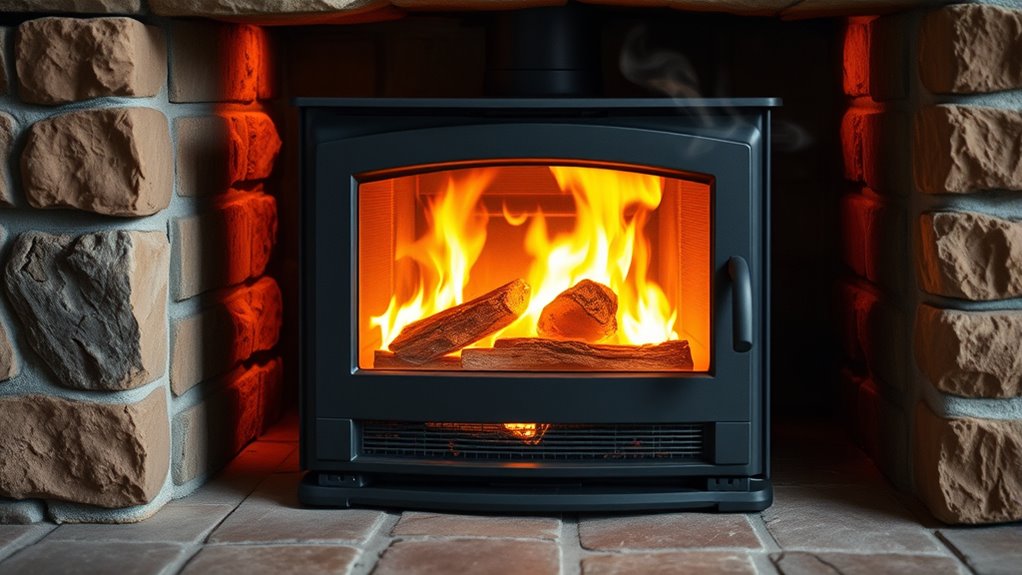
When evaluating wood stove inserts, you’ll notice that heat output can vary widely based on factors like size, material, and installation. Measuring efficiency isn’t always straightforward, as different methods can produce different results, making comparisons tricky. Understanding these variables helps you choose a model that balances strong heat performance with ideal energy use. Additionally, considering potential workaholic relationship struggles may influence how much attention you can dedicate to the maintenance and operation of your stove. Proper insulation and tuning for efficiency are key to maximizing heat output while minimizing fuel consumption.
Heat Output Variability
The heat output of wood stove inserts can vary considerably based on factors like size, design, and fuel type, making it essential to take into account real-world performance rather than just maximum ratings. BTU ratings provide a general idea of potential heat output, but actual heat output depends on firebox size, fuel type, and load size. For example, larger fireboxes offer longer burns and higher heat output, but efficiency depends on wood moisture and how well the stove is insulated. Load size and wood moisture directly influence heat output, causing fluctuations in BTU delivery. Even with high BTU ratings, poor insulation or incorrect sizing can limit effective heating. To maximize performance, you must consider these variables to ensure your stove’s heat output aligns with your space’s needs.
Efficiency Measurement Challenges
Evaluating the true efficiency and heat output of wood stove inserts is challenging because real-world conditions often differ substantially from standardized testing results. Efficiency ratings, typically based on standardized tests, don’t fully reflect actual performance, which depends on factors like combustion quality, installation, and maintenance. The EPA assigns default efficiency ratings—around 63% for non-catalytic and 72% for catalytic stoves—but independent tests sometimes reveal efficiencies over 80%. Measuring actual heat output is complicated by variables such as house insulation, airflow, and fuel type. Burn times and heat delivery vary with wood moisture, species, and load size. These measurement challenges, combined with inconsistent testing standards, make it difficult to accurately assess and compare the true energy efficiency and heating capabilities of different wood stove inserts.
Determining the Appropriate Heating Capacity and Burn Time
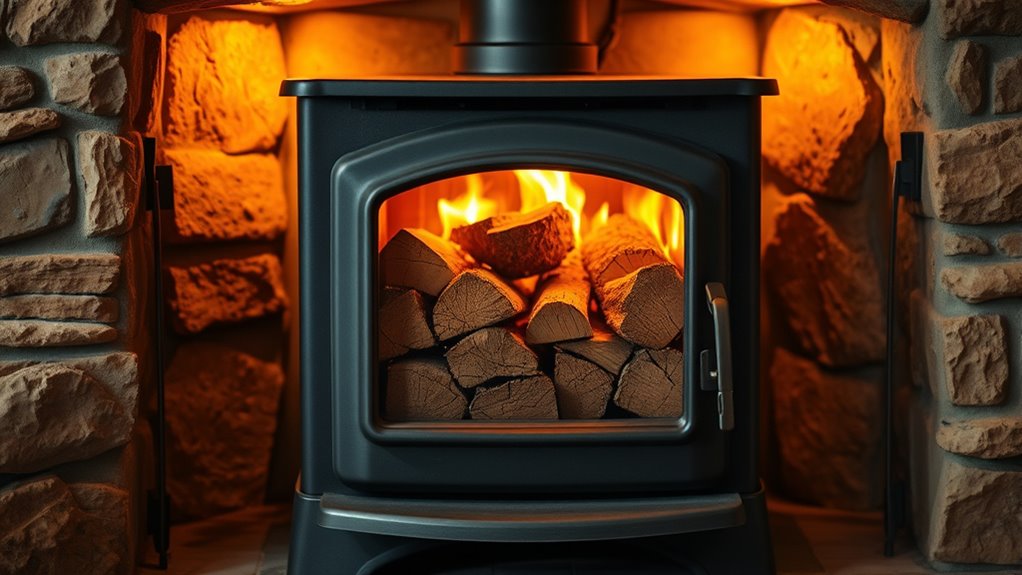
Choosing the right wood stove insert begins with understanding its heating capacity and burn time. Heating capacity, measured in BTUs, varies from 25,000 to 80,000 BTUs, but your house size, insulation, and climate influence how effectively it heats. A properly sized firebox accommodates the right log length and impacts burn time—larger fireboxes hold bigger logs for longer burns. Burn time depends on wood type; hardwoods like maple burn longer and produce more heat than softwoods such as spruce. To maximize efficiency, select an insert that matches your home’s demands, ensuring it provides consistent warmth without overworking its capacity. Proper sizing prevents short burns or insufficient heat, making your stove both effective and energy-efficient.
Choosing the Right Log Length and Additional Features
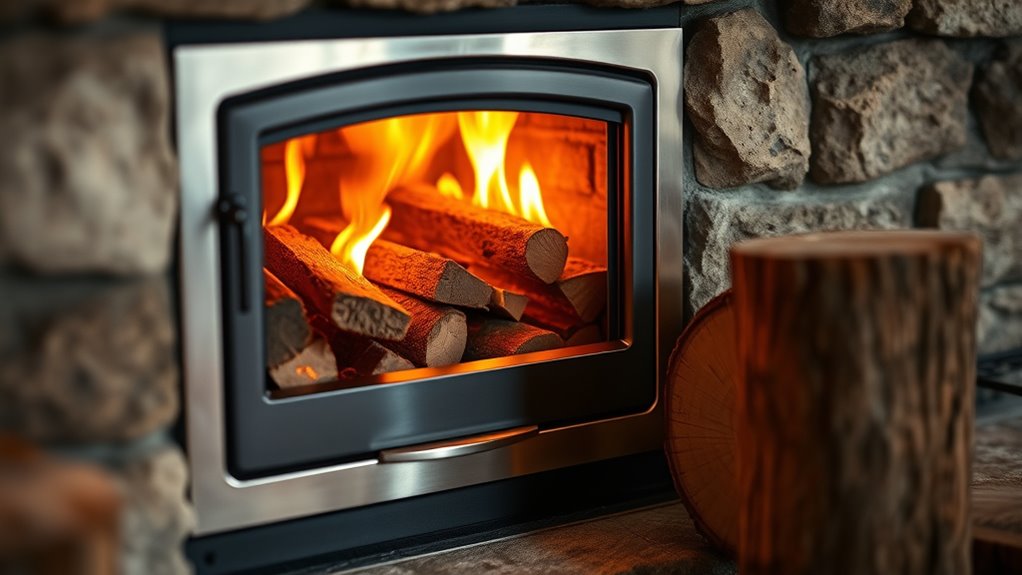
Selecting the right log length for your wood stove insert guarantees efficient burning and easier loading. Typically, firewood should be about 16 inches long to fit comfortably in the firebox, ensuring good combustion and safety. Logs longer than 16 inches may be difficult to load and can reduce efficiency since they don’t burn evenly. Larger logs don’t necessarily boost radiant heat; proper seasoning and size matter more. Many inserts accommodate logs up to 20 inches, but fitting them regularly can be challenging. To optimize performance, consider these features:
- Ash pans for easy cleanup
- Cooking surfaces for versatility
- Open operation options for airflow control
- Adequate combustion air for safety and efficiency
Choosing the right firewood and additional features guarantees your stove functions safely and effectively.
Weighing the Pros and Cons of Installing a Wood Stove Insert
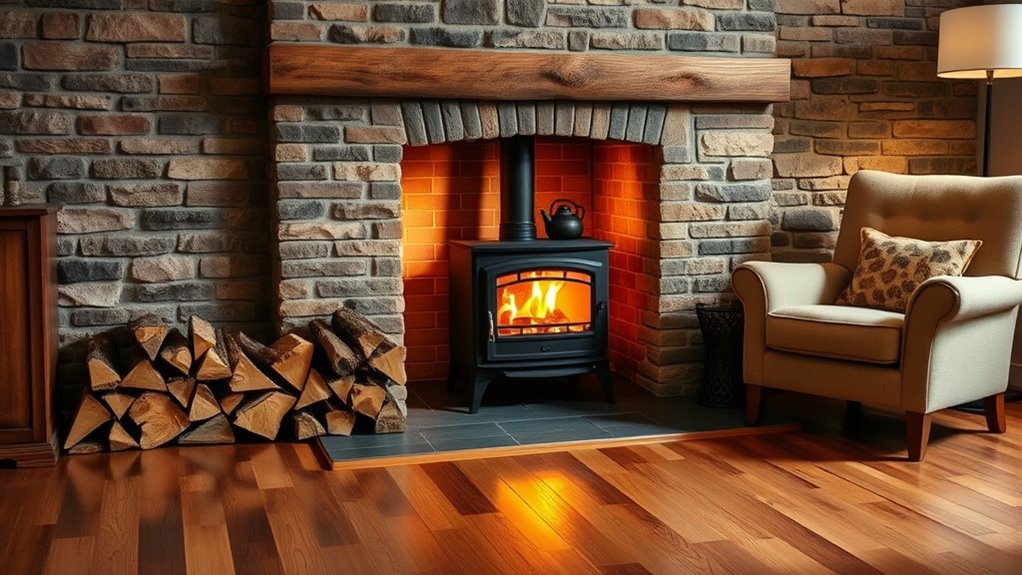
Installing a wood stove insert can greatly boost your home’s heating efficiency and help you save on fuel costs over time. A quality insert can increase heating efficiency by up to 75%, making your fireplace upgrade worthwhile. This means better home warmth and longer burn duration, reducing the need for frequent refueling. However, consider the initial costs, which often exceed $4,000, and understand that it may take over 15 years to recoup your investment through energy savings. Proper installation safety, especially venting, is essential to prevent creosote buildup and ensure safe operation. Weigh these benefits against the upfront expense and maintenance needs. If your home’s size, fireplace condition, and burn duration align with your goals, a wood stove insert could be a smart, energy-efficient choice.
Frequently Asked Questions
Are Wood Stove Inserts Worth It?
You wonder if wood stove inserts are worth it, and the answer depends on your priorities. You’ll save money over time with higher efficiency and lower fuel costs. Plus, you get safer, longer burns and better heat control. Although the initial cost is high, the savings, comfort, and environmental benefits can make it a smart investment for your home, especially if you use seasoned wood regularly.
What Are the Disadvantages of an Inset Stove?
You might think inset stoves are perfect, but they do have drawbacks. Installation can be costly and complicated, often exceeding $4,000, and they may have limited firebox size, restricting logs and overnight burns. Regular maintenance and proper venting are essential, or you risk safety hazards like smoke or creosote buildup. If not installed correctly, efficiency drops, and safety issues arise, making them less ideal for some households.
What Are the Cons of Fireplace Inserts?
You should consider that fireplace inserts can be pricey, often costing over $4,000, and it might take years to see savings. Installation and maintenance are essential; if you don’t do it right, it could be unsafe or less efficient. Also, they may produce soot or blackening if you don’t use seasoned wood. Plus, they might not heat large or poorly insulated spaces well. Compatibility issues can add to your costs too.
What Is the 3:2-10 Rule for Wood Stoves?
Did you know that following the 3:2-10 rule can improve your stove’s efficiency by guaranteeing proper draft and reducing creosote buildup? This rule suggests your flue diameter should be about 1.5 inches for every 2 feet of chimney height, with a maximum of 10 feet. By adhering to this guideline, you help prevent smoke spillage, backpuffing, and ensure consistent, clean-burning performance for your wood stove.
Conclusion
Ultimately, weighing the warmth, worth, and willingness to work will help you decide if a wood stove insert is right for you. Consider your space, safety, and style needs, then select smartly with solid specs and sustainable features. By balancing benefits and barriers, you’ll build a beautiful, cozy hearth that heats your home happily and efficiently. With wise choices, your wood stove insert will warmly welcome you for years to come.

